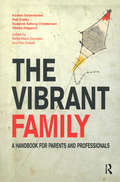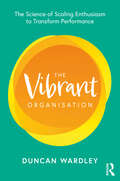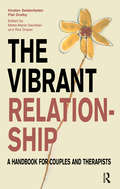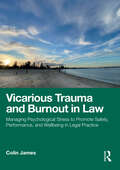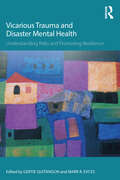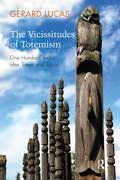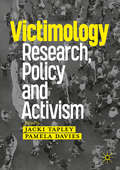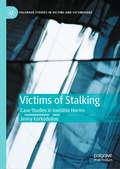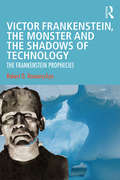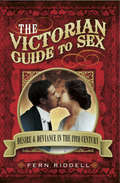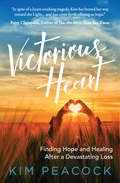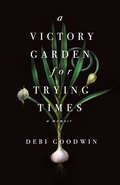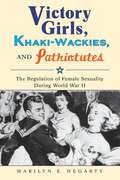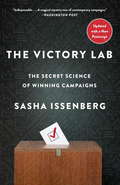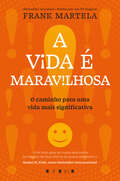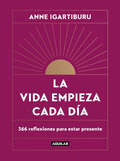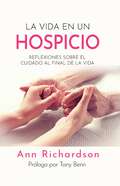- Table View
- List View
El viaje para sanar la sexualidad: Una guía para sobrevivientes de abuso sexual
by Wendy MaltzConsidered a classic in its field, this comprehensive guide will help survivors of sexual abuse improve their relationships and discover the joys of sexual intimacy. Wendy Maltz takes survivors step by step through the recovery process through exercises and innovative techniques. Based on the author's clinical work, interviews and workshops, we will find in this guide first-person accounts of women and men at each stage of sexual healing.This compassionate resource helps survivors to:• Identify the sexual effects of sexual abuse.• Eliminate negative sexual behavior and solve specific problems.• Gain control over bothersome automatic reactions to touch and sex.• Develop a healthy sexual self-conceptConsiderada un clásico en su campo, esta guía integral ayudará a los sobrevivientes de abuso sexual a mejorar sus relaciones y descubrir las alegrías de la intimidad sexual. Wendy Maltz lleva a los sobrevivientes paso a paso a través del proceso de recuperación mediante ejercicios y técnicas innovadoras. Basada en el trabajo clínico, las entrevistas y los talleres del autor, encontraremos en esta guía relatos en primera persona de mujeres y hombres en cada etapa de la curación sexual. Este recurso compasivo ayuda a los sobrevivientes a: Identificar los efectos sexuales del abuso sexual.Eliminar el comportamiento sexual negativo y resolver problemas específicos.Obtener el control sobre las reacciones automáticas molestas al tacto y al sexo.Desarrollar un autoconcepto sexual sano
The Vibes You Feel: What I’ve Learned about Life and Relationships through the Holy Spirit
by Kierra Sheard-KellyThis inspiring book for teens and young women explores what it means to listen to God&’s voice, better understand the &“vibes&” and intuition the Spirit uses as guidance, and live a life that proclaims your heavenly truth. Filled with personal lessons from author and Grammy-nominated artist Kierra &“Kiki&” Sheard-Kelly and empowering scriptural promises, you&’ll grow stronger in your faith as well as your God-given purpose.Each day, we are under attack—by people who want to keep us down or who doubt our gifts, as well as by spiritual forces who want to knock us off our God-given path and into the darkness. In The Vibes You Feel, Kierra &“Kiki&” Sheard-Kelly invites you to uncover what it means to have the Holy Spirit in your life, and how listening to the vibes we sense in certain situations can help steer us toward the future God intends. Inside The Vibes You Feel, you&’ll find:encouragement and support for navigating today&’s worldsolid biblical truths and scriptural promises that arm you for the tough decisions and battles in your lifeKierra&’s own personal stories and experiences with difficult situations, and the spiritual nudges that helped her throughAdvice and guidance with actionable steps In addition, The Vibes You Feel:is an ideal gift for birthdays, Christmas, Easter, or graduationshelps you grow closer to God and understand the signals he sendsis perfect for those looking for motivation and biblical guidance Also check out Kierra Sheard-Kelly&’s bestselling and inspirational book, Big, Bold, and Beautiful.
The Vibrant Family: A Handbook for Parents and Professionals (The Systemic Thinking and Practice Series)
by Susanne Soborg ChristensenThe Vibrant Family offers completely new and surprising approaches to parenthood. This book is not about child rearing, setting limits, or a specific way of communicating with children. It is about the ways in which well-being in our relationship is crucial to a good family life with confident and balanced children. The clear message of the book is that it is not the children who should change in order to get the family to function it is the parents. The book also offers practical and concrete tools to help you understand how you and your partner can learn to communicate and act in an accepting and close way, creating a climate in the family that encourages joy and growth.
The Vibrant Organisation: The Science of Scaling Enthusiasm to Transform Performance
by Duncan WardleyThe Vibrant Organisation translates the science of human behaviour into a playbook of highly practical interventions that build and scale enthusiasm, transforming organisational culture and performance. The book helps create more joy and fulfilment at work, whilst also steering a path to sustained competitive advantage. Using cutting-edge research in neuroscience and psychology, as well as the author’s considerable practical experience, Duncan Wardley offers a three-part framework for building teams of agile, adaptable, curious, and highly motivated people: Reset shows how to reduce the threat response by creating a safe environment for employees Ignite teaches leaders how to create events or experiences that create flashes of insight and motivation Fuel demonstrates how to sustain people’s motivation through repeatable actions, resulting in an upward spiral of enthusiasm. Packed with fascinating research, on-the-ground stories, and new scientific findings – along with practical tools and exercises – The Vibrant Organisation is a must read for business leaders at all levels looking to get the best out of themselves and their people.
The Vibrant Relationship: A Handbook for Couples and Therapists (The Systemic Thinking and Practice Series)
by Kirsten Seidenfaden Piet DraibyThe book is divided into easy to grasp sections of theory and practical exercises. In the first part of the book, two of Denmark's most experienced practitioners in couples' therapy, psychologist Kirsten Seidenfaden and psychiatrist Piet Drailby, explain why we tend to get confused about love. In the exercise section of the book, they provide some simple, yet very efficient, tools to help us find out where we lost our way and how we can remain in a loving vibrant relationship for the rest of our lives.
The Vicarious Brain, Creator of Worlds
by Alain BerthozGroping around a familiar room in the dark, relearning to read after a brain injury, navigating a virtual landscape through an avatar: all are expressions of vicariance—when the brain substitutes one process or function for another. Alain Berthoz shows that this capacity allows humans to think creatively in an increasingly complex world.
Vicarious Trauma and Burnout in Law: Managing Psychological Stress to Promote Safety, Performance, and Wellbeing in Legal Practice
by Colin JamesThis book integrates research on the causes, responses and protective strategies for vicarious trauma that are recognised in a range of human services and argues their relevance to the legal profession.Examining related conditions that are common among lawyers - including burnout, compassion fatigue and secondary trauma stress – the text reveals how lawyers’ vulnerability to trauma is aggravated by stigma against mental health concerns in workplaces with poor leadership, weak supervision, and an adversarial “law-as-business” approach. The author proposes adaptions to legal education and practice management to help lawyers cope with stress and trauma, use their work experiences to improve their self-awareness, maintain their wellbeing, and ultimately to thrive in their work. Rich in evidence-based practices, strategies and tools, this book serves to help individuals, workplaces and law schools become trauma-informed.An indispensable guide for lawyers, law firm managers and supervisors, as well as legal educators and students seeking to enhance their resilience, self-awareness and wellbeing in readiness for legal practice.
Vicarious Trauma and Disaster Mental Health: Understanding Risks and Promoting Resilience (Psychosocial Stress Series)
by Gertie Quitangon Mark R. EvcesVicarious Trauma and Disaster Mental Health focuses on the clinician and the impact of working with disaster survivors. Floods, hurricanes, tornadoes, mass shootings, terrorism and other large-scale catastrophic events have increased in the last decade and disaster resilience has become a national imperative. This book explores vicarious traumatization in mental health providers who respond to massive disasters by choice or by circumstance. What happens when clinicians share the trauma and vulnerability from the toll taken by a disaster with the victims they care for? How can clinicians increase resilience from disaster exposure and provide mental health services effectively? Vicarious Trauma and Disaster Mental Health offers insight and analysis of the research and theory behind vicarious trauma and compares and contrasts with other work-impact concepts such as burnout, compassion fatigue and secondary traumatic stress. It proposes practical evidence-informed personal strategies and organizational approaches that address five cognitive schemas (safety, esteem, trust, control and intimacy) disrupted in vicarious trauma. With an emphasis on the psychological health and safety of mental health providers in the post-disaster workplace, this book represents a shift in perspective and provides a framework for the promotion of worker resilience in the standard of practice in disaster management.
The Vicissitudes of Totemism: One Hundred Years After Totem and Taboo
by Gerard LucasAfter being the subject of many studies up until 1914, totemism seemed to disappear from the literature. The publication of Freud's work Totem and Taboo was initially greeted with silence, and subsequently with critical and hostile reactions. C. Levi-Strauss was one of the few to devote a book to totemism but considered it as an illusion, although a number of prominent members of the English school of Social Anthropology contested this view, describing the direction adumbrated by Freud's enquiry as "highly pertinent". Totemism appears in Freud's work as a way of dealing with one of the canonical forms of human destructiveness, namely parricide. Why did eminent men find it impossible to utilise Freud's book and those studies that followed it in the interwar period? The mass murders in Nazi Germany and Stalinist Russia, however different they may have been, both generated a profound sense of horror that made their consequences largely unrepresentable for Europeans for more than thirty years.
Victimology: Research, Policy and Activism
by Pamela Davies Jacki TapleyThis book explores what victimology, as both an academic discipline and an activist movement, has achieved since its initial conception in the 1940s, from a variety of experts’ perspectives. Focussing on nine, dynamic and contemporary case studies covering topics like violence against women and girls, bereaved family activism, and environmental victims and climate change activists, each chapter critically examines how different crime victims have been politicised and explores the impact of victim-centred reforms upon criminal justice professional cultures. This book comprehensively and critically examines the historical, social and political factors, including the work of activists, that have shaped the development of theories, policies and reforms in this field, including how victimhood has come to be understood and responded to. The chapters also consider the future developments of this area, including how digital technologies are creating new forms and experiences of victimisation. Speaking to undergraduates, postgraduates and professionals in criminal justice and third sector organisations, this book discusses the links between theory, policy and professional practice and how they contribute to and facilitate debates regarding what the role of crime victims is in a 21st century criminal justice system.
Victimology: A Comprehensive Approach to Forensic, Psychosocial and Legal Perspectives
by Rejani Thudalikunnil GopalanThe term victim refers to a person harmed, injured, or killed as a result of a crime, accident, or other event or action. Victimology focuses on the victimization in terms of psychological effects, impact on criminal justice system and new policies and it is a major aspect in the area of forensic field. Victimization can occur due to abuse, assault, maltreatment, war, terrorism, crimes and it can happen in different settings like home, school, and public. In the past, more emphasis was given to perpetrators and various theories tried explain the behavior of perpetrator and their offences. Recently, researchers started focusing different aspects of victimology and explored risk factors for becoming victim, reasons for repeated victimization, and forensic, psychological and social dimensions of victims and consequences of victimization. But there is a need for new theories and researches to have more thorough understanding of victimization. The field of criminology dealt with crimes and various theories has developed to explain why crime occurs and more focused on perpetrators. A crime involves perpetrator and victim and not much attention has been given to the victim until recently. What happens to a victim, what are the psychological and social consequences of a harmful act to a victim, vulnerabilities to become a victim are getting serious attention now a days and started influencing the criminal justice system. The psychological and social impacts of victimization may be a short or long duration but the impacts cannot be ignored. The legal remedies and psychological healings are important aspects of victimization. While considering these factors, the book would be focusing on origin and scope of victimology, different types of victimization such as sexual abuse, domestic violence, maltreatment, cyber crimes, war and terrorism, natural calamities, victimization at school and work place, human trafficking, crime against persons, crime against property, white collar crime, elder abuse, victim with disabilities, secondary victim and re-victimization and its psychological impacts and related issues. The book would also focus on victimology and forensic factors and its influence on criminal justice system in addition to the psychological management of victimization.
Victims and Memory After Terrorism (Victims, Culture and Society)
by Ana MiloševićThis book contributes to the study of collective memory and the sociology of terrorism by analysing the role of memorialization in relation to terrorism, its victims, and the broader society. While various social scientists have extensively theorized and analysed how trauma and memory interact, grow apart, and reinforce each other, this book puts the rights and needs of the victims centre-stage.Departing from the prescriptive, legal blueprints of memory, this book introduces the concept of ‘memorial needs’ to challenge and complement existing victimological frameworks. It critically assesses the efficacy of public memorialization and its success in assisting those affected by violence by exploring how victims engage with memory and memorialization. It investigates personal and collective responses to urban terrorism in Europe that have taken a wide range of forms including media coverage, spontaneous memorials and public mobilizations, literary and artistic works, trials, and controversial counter-terrorism measures. Making a case against the fetishization of memory as an overarching answer to curing visible and invisible wounds provoked by violence, Victims and Memory After Terrorism sends out a practical invitation to the field to 'repair symbolic reparations' in a way that memorialisation is not just an expression of potential, an aspiration for a more moral and just society and a promise of healing for the victimised.An accessible and compelling read, this book will appeal to students and scholars of victimology, criminology, sociology, politics and those interested in the relationship between collective memory and terrorism.
Victims of Stalking: Case Studies in Invisible Harms (Palgrave Studies in Victims and Victimology)
by Jenny KorkodeilouThis book explores the nature and impact of stalking and criminal justice system responses to this type of abuse based on the experiences and lived realities of victims. Drawing on in-depth interviews with 26 self-defined victims of stalking in England and Wales, it explores the psychological and social effects of this hidden and misunderstood form of interpersonal violence. Korkodeilou's work seeks to improve understanding regarding this type of abuse, contribute to feminist criminology and gender-based violence literature, and expand scholarly knowledge with her research's theoretical, methodological and practical implications. Victims of Stalking will appeal to academics in the fields of victimology, victimisation, gender-based and interpersonal violence, criminal justice system responses to victims and to criminal justice system professionals (e.g. police officers, probation officers, and lawyers).
Victor Frankenstein, the Monster and the Shadows of Technology: The Frankenstein Prophecies
by Robert D. RomanyshynIn Victor Frankenstein, the Monster and the Shadows of Technology: The Frankenstein Prophecies, Romanyshyn asks eight questions that uncover how Mary Shelley’s classic work Frankenstein haunts our world. Providing a uniquely interdisciplinary assessment, Romanyshyn combines Jungian theory, literary criticism and mythology to explore answers to the query at the heart of this book: who is the monster? In the first six questions, Romanyshyn explores how Victor’s story and the Monster’s tale linger today as the dark side of Frankenstein’s quest to create a new species that would bless him as its creator. Victor and the Monster are present in the guises of climate crises, the genocides of our "god wars," the swelling worldwide population of refugees, the loss of place in digital space, the Western obsession with eternal youth and the eclipse of the biological body in genetic and computer technologies that are redefining what it means to be human. In the book’s final two questions, Romanyshyn uncovers some seeds of hope in Mary Shelley’s work and explores how the Monster’s tale reframes her story as a love story. This important book will be essential reading for academics and students of Jungian and post-Jungian theory, literature, philosophy and psychology, psychotherapists in practice and in training, and for all who are concerned with the political, social and cultural crises we face today.
The Victorian Guide to Sex: Desire & Deviance in the 19th Century
by Fern Riddell“An enjoyable read and an informative survey of Victorian sexual tastes and preoccupations . . . a rigorously balanced account of this complex subject.” —Victorian SecretsAn exciting factual romp through sexual desire, practices and deviance in the Victorian era. The Victorian Guide to Sex will reveal advice and ideas on sexuality from the late 19th century. Drawing on both satirical and real-life events from the period, it explores every facet of sexuality that the Victorians encountered.Reproducing original advertisements and letters, with extracts taken from memoirs, legal cases, newspaper advice columns, and collections held in the Museum of London and the British Museum, this book reveals historical sexual proclivities.“Riddell’s book lifts the veil on historic sexual attitudes to illuminate the secrets of our ancestors’ lives. Written with wry humour in a pastiche of Victorian style, the book is both entertaining and highly informative.” —Your Family Tree
Victorious Heart: Finding Hope and Healing After a Devastating Loss
by Kim PeacockA mother shares how God&’s grace helped her through the loss of her child in this memoir of faith, healing, and hope in the midst of tragedy. Losing a loved one can leave you feeling broken, but grief is not something that can be fixed or cured. It is the experience of missing a part of yourself. In Victorious Heart, Kim Peacock openly recounts the devastating loss of her oldest daughter, Nicole, and reveals how the Lord carried her through―and is still carrying her through―the deepest sorrow of her life. For others who are experiencing terrible grief, Victorious Heart offers consolation and wisdom. Kim shares how she managed some of the difficult &“firsts&” like birthdays and holidays, and how she learned to avoid the &“Blame Game.&” Grieving family members learn that it will be okay to laugh again and that they too can have a Victorious Heart.
A Victory Garden for Trying Times
by Debi Goodwin“A compelling and intimate reflection on love and grief and ordinary things that comfort and sustain us.” — Alison Smith, award-winning journalist Ever since her childhood on a Niagara farm, Debi has dug in the dirt to find resilience. But when her husband, Peter, was diagnosed with cancer in November, it was too late in the season to seek solace in her garden. With idle hands and a fearful mind, she sought something to sustain her through the months ahead. She soon came across Victory Gardens — the vegetable gardens cultivated during the world wars that sustained so many. During an anxious winter, she researched, drew plans, and ordered seeds. In spring, with Peter in remission, her garden thrived and life got back on track. But when Peter's cancer returned like a killing frost, the garden was a reminder that everything must come to an end. A Victory Garden for Trying Times is a personal journey of love, loss, and healing through the natural cycles of the earth.
Victory Girls, Khaki-Wackies, and Patriotutes: The Regulation of Female Sexuality during World War II
by Marilyn E HegartyA study of how the U.S. government&’s World War II fight against venereal disease transformed into a war against women.Victory Girls, Khaki-Wackies, and Patriotutes offers a counter-narrative to the story of Rosie the Riveter, the icon of female patriotism during World War II. With her fist defiantly raised and her shirtsleeves rolled up, Rosie was an asexual warrior on the homefront. But thousands of women supported the war effort not by working in heavy war industries, but by providing morale-boosting services to soldiers, ranging from dances at officers&’ clubs to more blatant forms of sexual services, such as prostitution. While the de-sexualized Rosie was celebrated, women who used their sexuality—either intentionally or inadvertently—to serve their country encountered a contradictory morals campaign launched by government and social agencies, which shunned female sexuality while valorizing masculine sexuality. This double-standard was accurately summed up by a government official who dubbed these women &“patriotutes&”: part patriot, part prostitute. Marilyn E. Hegarty explores the dual discourse on female sexual mobilization that emerged during the war, in which agencies of the state both required and feared women&’s support for, and participation in, wartime services. The equation of female desire with deviance simultaneously over-sexualized and desexualized many women, who nonetheless made choices that not only challenged gender ideology but defended their right to remain in public spaces.
The Victory Lab: The Secret Science of Winning Campaigns
by Sasha IssenbergUPDATED FOR THE 2016 ELECTIONThe book Politico calls "Moneyball for politics" shows how cutting-edge social science and analytics are reshaping the modern political campaign.Renegade thinkers are crashing the gates of a venerable American institution, shoving aside its so-called wise men and replacing them with a radical new data-driven order. We've seen it in sports, and now in The Victory Lab, journalist Sasha Issenberg tells the hidden story of the analytical revolution upending the way political campaigns are run in the 21st century. The Victory Lab follows the academics and maverick operatives rocking the war room and re-engineering a high-stakes industry previously run on little more than gut instinct and outdated assumptions. Armed with research from behavioural psychology and randomized experiments that treat voters as unwitting guinea pigs, the smartest campaigns now believe they know who you will vote for even before you do. Issenberg tracks these fascinating techniques--which include cutting edge persuasion experiments, innovative ways to mobilize voters, heavily researched electioneering methods--and shows how our most important figures, such as Barack Obama and Mitt Romney, are putting them to use with surprising skill and alacrity. Provocative, clear-eyed and energetically reported, The Victory Lab offers iconoclastic insights into political marketing, human decision-making, and the increasing power of analytics.
A Vida É Maravilhosa: O Caminho para Uma Vida Mais Significativa
by Frank MartelaUm guia inspirador que oferece ferramentas práticas e facilmente aplicáveis para uma experiência de vida mais positiva, gratificante e significativa. O que dá sentido à nossa vida? Como podemos lidar com a ausência de um propósito existencial? Valerá a pena focarmo-nos na busca permanente de felicidade? Perceber o sentido da própria existência é fundamental para vivermos com motivação, satisfação e alegria e, sobretudo, para conseguirmos tirar o máximo partido da vida. Vários estudos sugerem que as pessoas com uma forte noção do seu propósito existencial têm mais saúde e vivem mais e melhor. Neste livro, Frank Martela esclarece por que motivo sentimos uma insatisfação permanente e estamos constantemente à procura de algo mais. Numa série de reflexões perspicazes e motivadoras, dotadas de um refinado sentido de humor, o autor analisa as grandes questões existenciais no contexto da vida moderna, oferecendo uma nova abordagem para alcançarmos uma vida mais plena, que passa por fazermos coisas significativas para nós (realização pessoal)de uma forma que nos torne significativos para outras pessoas (realização social). «Um livro para ler vezes sem conta na viagem de descoberta do nosso propósito.» Daniel H. Pink, autor bestseller internacional «Apoiando-se habilmente em áreas como a psicologia, a filosofia e a literatura, este livro irá ajudá-lo a viver uma vida com significado. Uma leitura tão gratificante e divertida quanto enriquecedora.» Emma Seppala, diretora científica do Centro de Educação e Pesquisa sobre Compaixão e Altruísmo da Universidade de Stanford «Um livro brilhante e encantador que aborda as questões mais grandiosas da vida com simplicidade, humor e perspicácia. Se tem curiosidade sobre o sentido da vida — e quem não tem? —, este livro é um recurso valioso.» Roy F. Baumeister, autor bestseller internacional «Neste ensaio edificante, fruto de um cuidadoso trabalho de pesquisa, Frank Martela reúne algumas das ideias mais fascinantes da história, da filosofia e da psicologia para abordar a questão mais premente de todas: o que torna a vida significativa.» Emily Esfahani Smith, autora bestseller internacional
Vida emocionalmente inteligente: Estrategias para incrementar el coeficiente emocional
by Geetu Bharwaney Juan Castilla PlazaUn libro obligatorio para quien desee tener un mayor conocimiento sobre inteligencia emocional.Reuven Bar-On, editor del libro The Handbook of Emotional Intelligence (Manual de inteligencia emocional).Vida emocionalmente inteligente no es un libro para leer, sino para hacer, ya que pone en práctica la teoría de la inteligencia emocional. Si el concepto de inteligencia emocional te es desconocido, no te preocupes, ya que empieza con un breve resumen de lo que es la inteligencia emocional, y lo explica utilizando términos que no requieren conocimientos previos de psicología. Además, nos da la gran noticia de que la inteligencia emocional puede aprenderse y que el coeficiente emocional también puede desarrollarse.Vida emocionalmente inteligente contiene un programa único de mejora que aumentará tu habilidad para utilizar las emociones de forma eficiente. Está repleto de estrategias para controlar las emociones, además de unas ideas muy inspiradoras para enfocar tus sentimientos. Te ofrece el mejor método para vivir una vida emocionalmente inteligente.Geetu Bharwaney es la fundadora y directora de EI World Limited, una empresa a la vanguardia de las innovaciones relacionadas con la inteligencia emocional y los programas de desarrollo en Europa. Geetu es conocida por ser una de las pioneras en el campo de la inteligencia emocional.
La vida empieza cada día: 366 reflexiones para estar presente
by Anne Igartiburu«La vida es lo que sucede aquí y ahora». Un libro repleto de reflexiones y aprendizajes de Anne Igartiburu para cada día del año. Vivir no es algo estático. La vida se destruye y se construye con cada respiración, con cada tictac, con cada amanecer y cada pequeño gesto. Por eso, este libro es un compañero ideal en la aventura de existir. En su interior atesora 366 reflexiones que te invitan a ser consciente de quién quieres ser en cada momento, a estar más cerca de ti mismo y a vivir más intensamente el momento presente. Anne Igartiburu, comunicadora desde hace más de dos décadas, es una de las presentadoras de televisión más queridas y reconocidas de nuestro país. Durante los últimos años ha desempeñado una bonita labor de divulgación en el ámbito del bienestar emocional, una de sus grandes pasiones y en la que se ha formado con algunos de los mejores profesionales de distintos campos. Sus encuentros con expertos en psicología, psiquiatría, neurociencia o filosofía en sus diferentes canales de difusión y en su Podcast Mi Latido de Más le han otorgado gran reconocimiento. En este libro quiere compartir algunos de sus más preciados aprendizajes fruto de este trabajo.
La Vida en un Hospicio: Reflexiones sobre el cuidado al final de la vida
by Ann RichardsonLa muerte es un tema incómodo. A nadie le gusta pensar cómo serán nuestros últimos días. Pero si es que pensamos en ellos, queremos que estén llenos de paz y tranquilidad, con la oportunidad de despedirnos de nuestros seres queridos. La Vida en un Hospicio te permite dar un vistazo al cuidado del final de la vida, donde verás los enormes esfuerzos de las enfermeras, doctores, capellanes y el resto del personal, incluyendo a un considerado cocinero, para brindar la calma que todos esperamos. Quizás estás buscando cuidados del final de la vida para algún ser querido. Quizás te preguntes si éste trabajo es para ti. O sólo tienes ganas de ser inspirado por la humanidad en su mejor momento. Este libro es para ti. ALTAMENTE RECONOCIDO por la Asociación Médica Británica (BMA), 2008 “Las reflexiones simples sobre los temas complejos del cuidado se quedan contigo mucho tiempo después de haber terminado el libro.” Boletín del foro de Enfermería Oncológica Royal College of Nursing (Real Colegio de Enfermería) “Un libro fácil de leer, lo cual puede ser una sorpresa para muchos profesionales y lectores en general por su ligereza, humanidad y tono refrescante. Es reconfortante leer estos relatos honestos del trabajo con los pacientes al final de la vida.” Dra. Nansi-Wynne Evans, Médico General Concurso de libros médicos de BMA
La vida sigue
by Jorge BaficoEste libro es un recorrido y un homenaje. Una invitación a conocer las zonas más complejas de la psique humana, a través de diferentes historias de pacientes. También es un homenaje a la figura de Dagoberto Puppo, un gran médico que ha sido maestro, ejemplo y amigo del autor. El psicoanalista Jorge Bafico y el psiquiatra Dagoberto Puppo recorrieron un largo camino juntos. Un sólido vínculo afectivo y profesional los arropó mientras trabajaron con muchos pacientes. Tras el fallecimiento de Dagoberto en abril de 2009, Jorge supo que tenía que escribir este libro. Recorriendo sus páginas, el lector se encontrará con casos clínicos que tocan la locura, y que al mismo tiempo se convierten en cercanos. Bafico nos acerca a la patología en su versión más cotidiana, desde el respeto y una profunda sensibilidad. Un encuentro con la clínica desde dentro, moldeada a través del vínculo con Dagoberto. Este libro es también un homenaje a un gran médico que ha sido maestro, ejemplo y amigo del autor. Cómo él mismo dice: #Hay hombres que son excepcionales. Dagoberto lo fue y yo tuve la suerte de conocerlo#. Con un lenguaje directo y luminoso, Jorge Bafico nos invita a conocer esta historia de aprendizajes, gratitud y esperanza, pero también de angustia y dolor. Fiel a su estilo, cada texto está acompañado por citas musicales que complementan y amplifican el sentido de cada capítulo.
Video and Filmmaking as Psychotherapy: Research and Practice (Advances in Mental Health Research #4)
by J. Lauren Johnson Joshua L. Cohen Penny OrrWhile film and video has long been used within psychological practice, researchers and practitioners have only just begun to explore the benefits of film and video production as therapy. This volume describes a burgeoning area of psychotherapy which employs the art of filmmaking and digital storytelling as a means of healing victims of trauma and abuse. It explores the ethical considerations behind this process, as well as its cultural and developmental implications within clinical psychology. Grounded in clinical theory and methodology, this multidisciplinary volume draws on perspectives from anthropology, psychiatry, psychology, and art therapy which support the use and integration of film/video-based therapy in practice.


